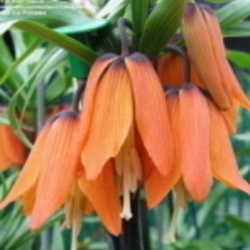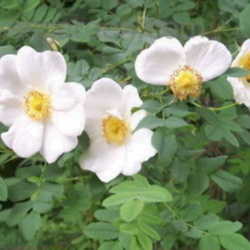(Editor's Note: This article was originally published on May 1, 2009. Your comments are welcome, but please be aware that authors of previously published articles may not be able to promptly respond to new questions or comments.)
Climbing plants are one of the best types of plants to have in the garden. Climbing vegetable plants allow those with limited space to grow fresh produce on a patio or even a balcony. For the ornamental grower, vines are one of the easiest ways to separate garden spaces. A fast-growing vine will cover an arbor or trellis in once season.
When strategically placed, vine-covered structures can help to create garden rooms. What better way to create a private secret garden than with fragrant flowering vines? A few vines which will accomplish this are listed below along with basic characteristics of each.
Vines for Covering Outdoor Structures
 Wisteria frutescens by Dave's Garden member 'Nyssa416' |
 Solandra maxima by Dave's Garden member 'sa_haiad' |
 Stephanotis floribunda by Dave's Garden member 'blackthumbX2' |
 Beaumontia grandiflora by Dave's Garden member 'rjuddharrison' |
|
American wisteria (Wisteria frutescens) *All parts of plant are poisonous if ingested. This species is less aggressive than Asian varieties, but wisteria is invasive in many areas. Keep plant in check with pruning. Height: 8 to 20 feet. Grow in full sun to partial shade in zones 6a to 9b. Blooms are blue-violet or violet-lavender in mid-spring. Vine is evergreen.
Armand clematis (Clematis armandii) Height: 10 to 40 feet. Grow in full sun in zones 6a to 9b. Blooms are white or near-white from winter to mid spring.
Australian waxflower (Hoya australis) *Parts of plant are poisonous if ingested. Height: 15 to 20 feet. Grow in full sun to partial shade in zones 10b to 11. Blooms are white to near-white or cream to tan. Blooms appear in late summer through early fall. Vine is evergreen.
Variegated confederate jasmine (Trachelospermum jasminoides 'Variegatum')*All parts of plant are poisonous if ingested. Handling plant may cause skin irritation or allergic reaction. Height: 15 to 40 feet. Grow in full sun to partial shade in zones 8a to 11. Blooms white-near white from mid-spring to early summer. Vine is evergreen.
Cup of gold vine (Solandra maxima) *All parts of plant are poisonous if ingested Height: 30 to 40 feet. Grow in full sun in zones 8b to 11. Blooms are yellow-orange to bright yellow from late winter to early spring and then again from mid fall to late winter. Vine is evergreen.
Madagascar jasmine (Stephanotis floribunda) Height: 12 to 15 feet. Grow in full sun to partial shade in zones 10a - 11. Blooms are bright white and appear from mid-summer to early fall.
Madeira vine (Anredera cordifolia) *Plant is said to be invasive and difficult to eradicate in some areas; use caution when planting. Height: 12 to 20 feet. Grow in full sun in zones 10a to 11. Blooms are white to near-white from late summer to mid-fall. Vine is evergreen.
Nepal trumpet flower (Beaumontia grandiflora) Height: 12 to over 40 feet. Grow in full sun in zones 10a to 11. Blooms are white to near white from late spring to early summer. Vine is evergreen.
Rangoon creeper (Quisqualis indica) *May be invasive. Plant has spines. Height: over 40 feet. Grow in full sun in zones 10a to 11. Blooms are red and pink to near white from late spring to mid fall. Vine is evergreen.
Winter jasmine (Jasminum polyanthum) Height: 12 to 15 feet. Grow in full sun in zones 9a to 10b. Blooms are white to near white appearing throughout the year. Vine is evergreen.
For a real treat, plant fragrant vines near a bedroom window or sleeping porch, and near pathways leading to your home. The sweet scents will be carried on the breeze into sleeping and sitting areas of your home. When planted over or along pathways leading to your home, the fragrance welcomes guests in a way they will not soon forget.
Happy Gardening
Sources:
Plant characteristics and care tips are a condensed version of what is found in Dave's Garden PlantFiles. Please visit PlantFiles for more information and great member photographs.
Photos:
Photo at top right is rangoon creeper (Quisquarlis indica) by Dave's Garden member, ‘sa_haiad.'
All other photos are by Dave's Garden members and are credited above.


















